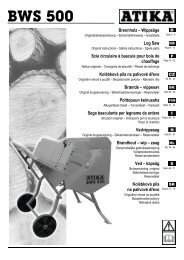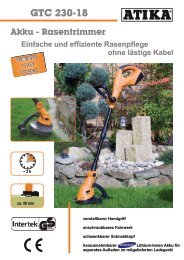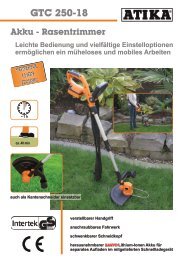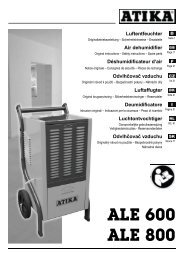Create successful ePaper yourself
Turn your PDF publications into a flip-book with our unique Google optimized e-Paper software.
3. Place a container under the log splitter to catch the old<br />
oil. The container should have a capacity of at least<br />
10 litres.<br />
4. Screw off the drain plug to allow the oil to flow out.<br />
5. Insert the seal and drain plug again.<br />
6. Pour in the new hydraulic oil (approx. 5.5 litres) using a<br />
clean funnel.<br />
7. Clean the dipstick and the oil seal.<br />
8. Check the oil seal and replace it if it is damaged in any<br />
way.<br />
9. Replace the dipstick.<br />
Dispose of the old oil properly (local oil disposal point).<br />
The old oil must not be poured into the ground or<br />
drainage system, or mixed with other waste.<br />
� Hydraulic oil<br />
We recommend the following hydraulic oils for the hydraulic<br />
cylinder:<br />
� Shell Tellus T 22<br />
� Aral Vitam Gf 22<br />
� BP Energol HLP 22<br />
� Mobil DTE 11<br />
� or equivalent<br />
Do not use any other types of oil. The use of any other<br />
type of oil will adversely affect the operation of the<br />
hydraulic cylinder.<br />
Please note the enclosed assembling<br />
sheet!<br />
Cleaning / replacing the air filter<br />
(36)<br />
Clean the air filter from dust and dirt on a regular basis to<br />
prevent<br />
− starting problems,<br />
− loss of output,<br />
− too high fuel consumption.<br />
Clean the air filter every 50 operating hours, or more<br />
frequently in dusty environments (every 10 hours).<br />
34<br />
1. Unscrew only the machine knob nut and remove the<br />
cover (29).<br />
2. Unscrew the wing nut and remove the air filter (36).<br />
3. Remove the foam filter (36A) from the paper filter<br />
(36B).<br />
4. Inspect both air filter elements. Replace the elements if<br />
damaged.<br />
5. Clean the filter elements if they are re-used.<br />
Paper filter: To remove the dirt, tap the filter several<br />
times against a hard surface. You can also<br />
blow the filter clean with compressed air (not<br />
over 2.07 bar).<br />
Foam filter: Wash the air filter in warm soap water. Rinse<br />
well. Squeeze the filter in a dry and clean<br />
cloth. Allow the filter to dry well. Dip the filter<br />
into engine oil and then squeeze it in a dry<br />
and clean cloth to remove surplus oil. The<br />
engine smokes if the foam contains too<br />
much excess oil.<br />
6. Clean the air filter mounting plate (37) and seal (40)<br />
with a wet rag. Make sure that no dirt enters the air line to<br />
the carburetor.<br />
7. Place the foam filter on the paper filter. Install the<br />
complete air filter again. Tighten the wings nuts. Pay<br />
attention that the seal (40) is installed under the air filter.<br />
8. Clean the cover with a wet rag.<br />
9. Re-mount the cover.<br />
� Never operate the machine without air filter. Dust and<br />
dirt can enter the engine and cause damages to the<br />
machine.<br />
Replace the air filter on a regular basis.<br />
� Damaged air filters must be replaced without delay.<br />
Checking / replacing the spark plug (38)<br />
Do not touch the spark plug or the spark plug connector<br />
while the engine is running. High voltage!<br />
Risk of burning on the hot engine. Wear protective<br />
gloves.<br />
Check the spark plug and the spark gap on a regular basis.<br />
For this proceed as follows:<br />
1. Allow the engine to cool down.<br />
2. Unscrew only the machine knob nut and remove the<br />
cover (29).<br />
3. Unscrew the wing nut and remove the air filter (36).<br />
4. Pull the spark plug connector (35) from the spark<br />
plug (38).<br />
5. Remove the spark plug using the supplied spark plug<br />
wrench (39).<br />
6. Clean the spark plug when it is<br />
contaminated.<br />
7. The electrode gap must be 0.7 – 0.8 mm.<br />
8. Carefully screw in the spark plug by hand to<br />
prevent damage to the thread.<br />
9. Now tighten the spark plug with the spark<br />
plug wrench.<br />
� Used spark plug: 1/8 – 1/4 turn



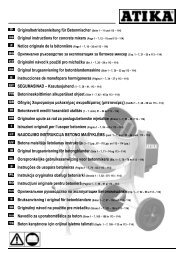
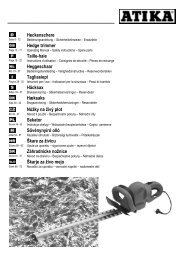
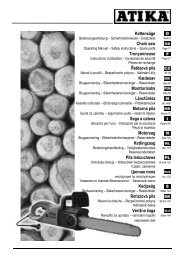
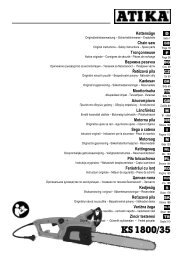
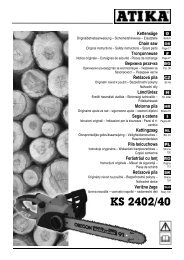
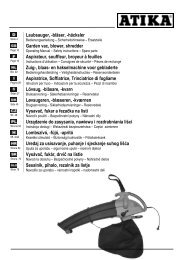
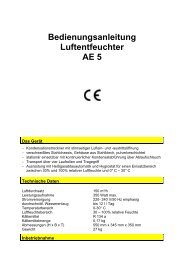
![BWS 400 AT] Km - Atika](https://img.yumpu.com/4285119/1/184x260/bws-400-at-km-atika.jpg?quality=85)
![BWS 600/ BWS 700 AT] KB? - Atika](https://img.yumpu.com/4285108/1/182x260/bws-600-bws-700-at-kb-atika.jpg?quality=85)
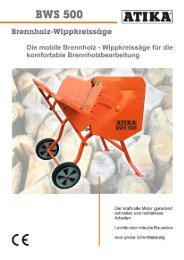
![BWS 400 AT] Km - Atika](https://img.yumpu.com/4285087/1/185x260/bws-400-at-km-atika.jpg?quality=85)
